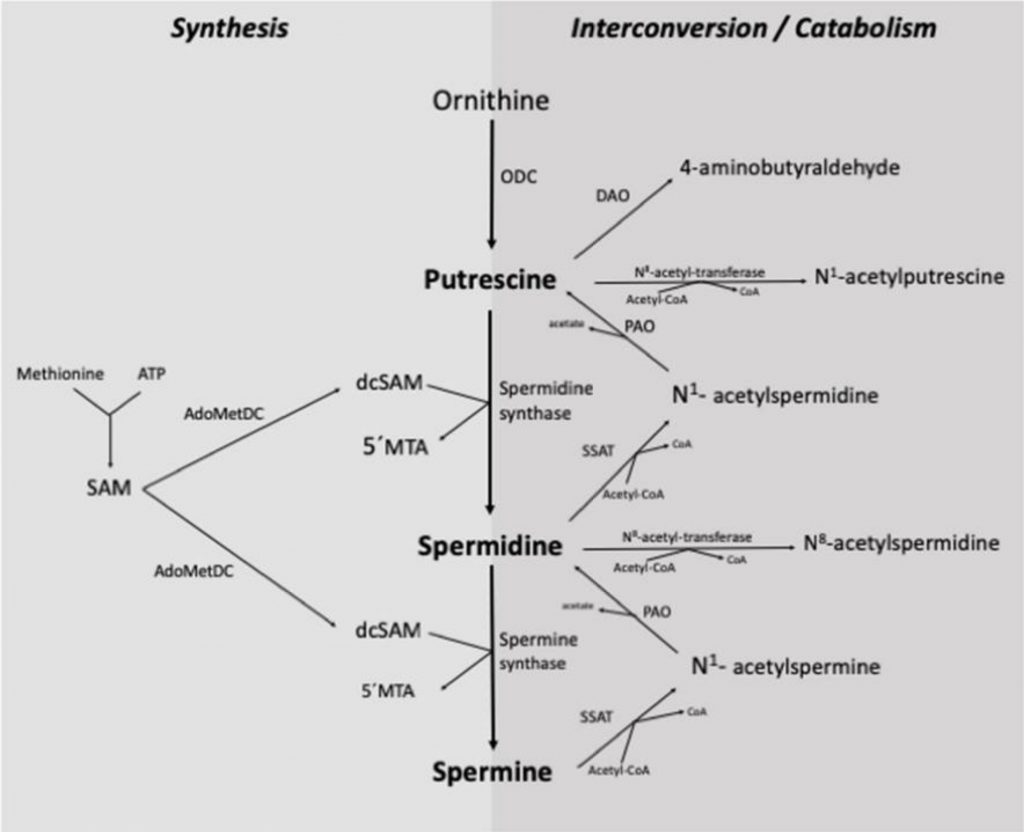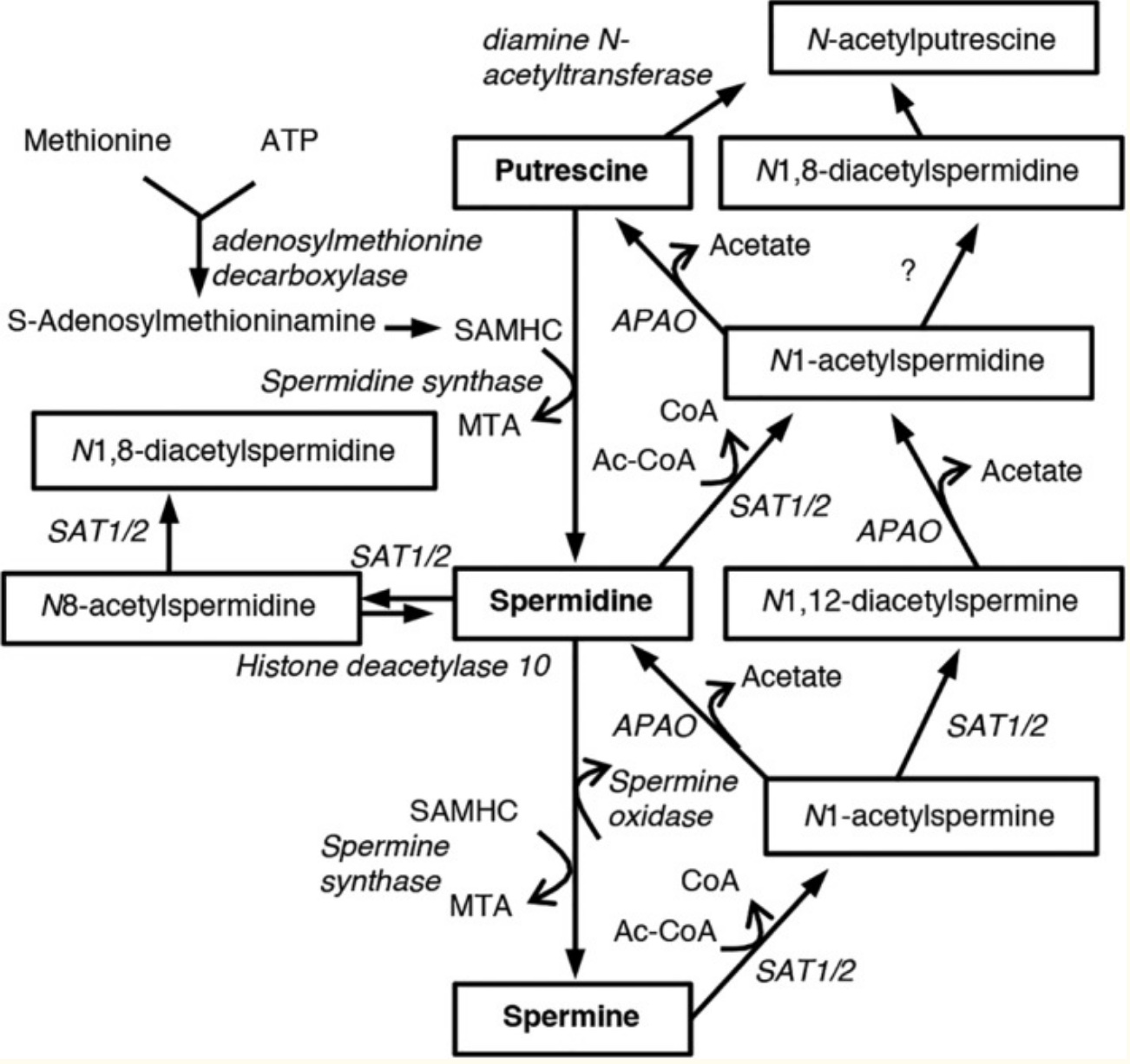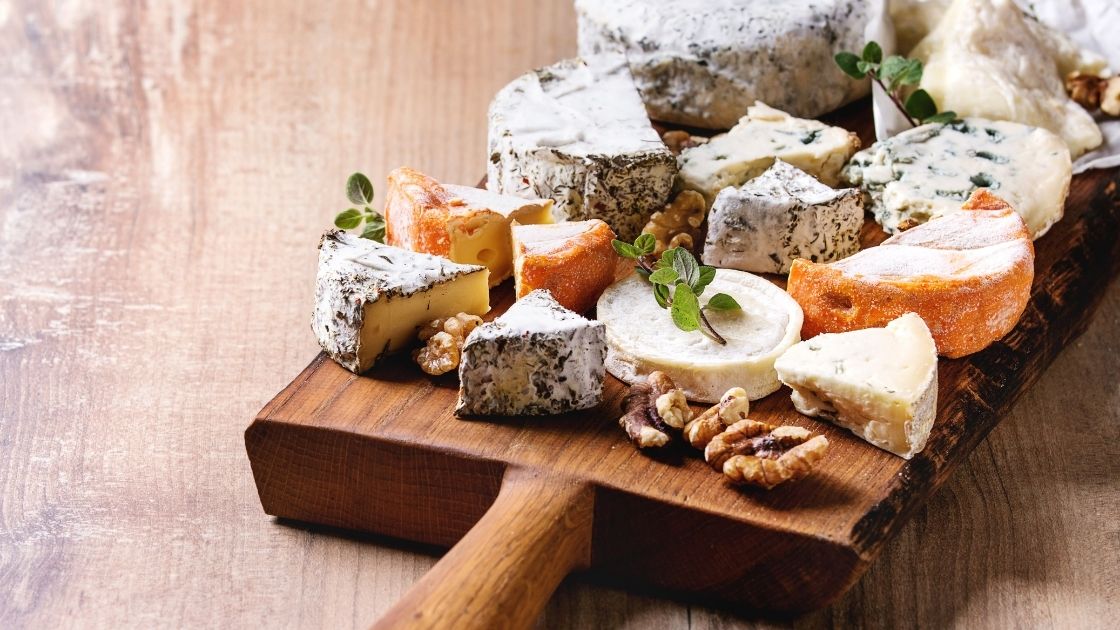Spermidine is a biogenic amine with many potential anti-aging benefits, ranging from extending healthspan to improving vaccine efficacy in older adults.
I’ll dig into the research on the topic, explore the clinical trials, and explain why increasing spermidine can sometimes be a bad idea. For this supplement, it is essential to go beyond the headlines and understand both the pros and the cons.
Spermidine: Longevity superstar?
Researchers have known for over a decade that spermidine supplementation can increase lifespan in many model organisms, including c. elegans and mice. Experiments have repeatedly shown both life and healthspan extension of up to 25%.[ref][ref][ref]
In 2012, researchers found that spermidine and other polyamine levels were significantly lower in older people (ages 60-80) when compared with younger adults. Interestingly, though, this pattern didn’t hold true for healthy centenarians and nonagenarians. The long-lived people had relatively higher spermidine and spermine levels than the 60 to 80-year-old group.[ref]
These tantalizing clues to spermidine’s role in longevity and healthspan have prompted a plethora of research studies with exciting results.
But first, let’s go over some of the background science to make all of this make sense.
What is spermidine?
Spermidine is a polyamine, which means that it is an organic compound with two amino groups.
This biogenic amine has many roles in the body:[ref]
- Polyamines are essential for cell growth and proliferation, stabilizing DNA and RNA transcription.
- Spermidine is important in inducing autophagy in cells that are damaged and need to be recycled. Autophagy is necessary for aging, both for recycling cellular components and clearing out damaged parts of the cell.
- In addition to regulating autophagy, spermidine downregulates IL-6, an inflammatory cytokine, in the aging brain.[ref]
- Spermidine is also a potent modulator of circadian clock gene expression.[ref]
In animal studies, spermidine supplementation extends lifespan a bit, but it also decreases heart disease. Researchers have found that the cardioprotective effects are achieved through increasing autophagy in cardiac muscle cells.[ref]
Important here: Spermidine and polyamine levels decrease in aging. Higher spermidine levels have links to healthy longevity, but there are some trade-offs as well.
Now let’s dig into the science…
Creation of spermidine in the body:
The spermidine synthase enzyme catalyzes the production of spermidine from putrescine and decarboxylated S-adenosylmethionine (SAMe). What does this mean? The enzyme is essential for the reaction, and the substrates needed are putrescine and SAMe.

What is putrescine?
Putrescine is a polyamine produced by the breakdown of amino acids. It is named putrescine because it is responsible for the foul odor in decaying flesh. In living people and all eukaryotic organisms, cells need putrescine for division.
A 2012 study shows that low putrescine levels are likely the driving factor for low spermidine levels in aging.[ref] This makes targeting an increase in putrescine one way to increase spermidine.
So how do we get putrescine?
Putrescine can be synthesized in a couple of ways. One way that may be ‘hackable’ is that arginine can be converted into ornithine and then putrescine.
Arginine -> Ornithine -> Putrescine
Utilize your gut microbes:
Researchers found that a probiotic (Bifidobacterium animalis subsp. lactis ) plus arginine increases putrescine production in the gut.[ref] After completing the animal studies showing the increase in putrescine, the researchers took it one step further in the human studies. They found that the specific Bifido in yogurt plus arginine improved endothelial function and reduced the risk of atherosclerosis. The yogurt plus arginine increased both putrescine and spermidine levels.[ref]
What is SAMe?
S-adenosylmethionine (SAMe) is the other essential component needed for the body to make spermidine. SAMe is the primary methyl donor in the body, shuttling methyl groups created in the methylation cycle for many reactions. Methyl groups are created in the body from consuming either folate- or choline-rich foods.
Spermidine and the hallmarks of aging:
Spermidine inhibits several of the hallmarks of aging.[ref][ref]
- epigenetic changes
- impaired proteostasis
- mitochondrial dysfunction
- stem cell dysfunction
- impaired intercellular communication
Clinical trials on spermidine supplementation for aging:
The correlation between low spermidine levels and diseases of aging, such as dementia or Alzheimer’s, has been shown in several trials.[ref] The question, though, is whether increasing the polyamine will prevent or reverse diseases of aging.
Spermidine clinical trials for dementia or Alzheimer’s:
Clinical trials on spermidine in the elderly show varying results. The differences in outcomes may be from the age at the start or the degree of cognitive impairment in dementia trials.
Supplemental spermidine in older adults with cognitive decline found no difference after 1.2 mg/day for three months. The supplement was safe and well-tolerated. It just wasn’t a miracle cure for dementia in three months.[ref]
Another clinical trial in older adults with memory problems, though, did find that it helped moderately with cognitive function.[ref]
A double-blinded study in nursing home patients found that spermidine supplementation improved cognitive performance in people with mild dementia.[ref]
Overall, the study results point to a supplement that may be worth trying, but one that is likely not a complete miracle pill for dementia.
Spermidine supplementation may improve vaccine efficacy in older people:
Autophagy is important in T cell function, and both decrease with aging. The decrease leads not only to decreased immune function but also leads to vaccines not being as effective.
A study in 2020 showed that “Spermidine supplementation in T cells from old donors recovers their autophagy level and function, similar to young donors’ cells, in which spermidine biosynthesis has been inhibited.” [ref] This research in older adult T cells follows animal research studies showing that older animals have an improved T cell response when supplemented with spermidine.[ref]
Spermidine and spermine levels in Parkinson’s:
A 2019 study shows lower levels of spermine and spermidine in people with Parkinson’s disease than in an age-matched cohort. Interestingly, a metabolome analysis showed higher levels of acetylspermidine and N-acetylputrescine, which are metabolites of spermidine.[ref]
Here is an in-depth look at spermidine biosynthesis and metabolism:

Spermidine and cancer: caution is needed
In cancer, spermidine seems to be a double-edged sword.
On the one hand, researchers find that it enhances autophagy to prevent cancerous mutations from replicating.[ref] High intake of spermidine-rich foods is associated with better outcomes in very early cancer cases.[ref]
But once a tumor starts to grow, higher levels of polyamines help to promote growth. Blocking the formation of polyamines is, therefore, a target of cancer researchers.[ref] In fact, a polyamine-reduced diet showed a benefit in prostate cancer in a clinical trial.[ref]
Heart disease and spermidine:
Animal studies show that supplemental spermidine in their food increases lifespan, in part, through enhancing heart health.
The researchers have found that adding spermidine to the food of lab animals decreased the age-associated decline in heart function. The spermidine-fed mice had reduced blood pressure and no decline in the cardiac muscles. Researchers determined that spermidine prevented the decline in autophagy in cardiac muscles that usually causes heart problems in aging.[ref]
It may seem odd that autophagy is significant for preventing heart problems. Autophagy is a cell survival strategy that helps cells survive damage from inflammation, nutrient deprivation, and reactive oxygen species. Autophagy is essential for pruning out damaged mitochondria and encouraging the formation of new powerhouses for the cell. On the other hand, over-activation of autophagy can lead to cell death. Thus, like everything in the body, it is a matter of balance.
In the heart, autophagy is essential for keeping the heart muscles functioning well. In animals with genetic modifications to reduce autophagy, cardiac hypertrophy or dilated cardiomyopathy occurs at an early age. Spermidine is important in autophagy, and counteracting the decrease in aging helps prevent declining heart function in the elderly.[ref]
Animal research also shows that spermidine increases the viability of heart muscle cells after a heart attack.[ref]
A human research study found that older adults who consumed more spermidine in foods were more likely to have lower all-cause mortality and decreased heart disease.[ref]
Spermidine for hair growth?
Animal studies show that spermidine supplementation suppresses heart problems in aging and decreases age-induced hair loss.[ref]
Spermidine is needed for normal hair growth. In fact, one way to stop excess hair growth in women is to apply a topical inhibitor of the enzyme that makes putrescine and spermidine.
A placebo-controlled human trial found that spermidine supplements for three months prolonged the anagen phase in hair. The anagen phase is the active growth phase of hair, so prolonging it can theoretically keep the hair around longer.[ref]
How can you increase spermidine?
For many, an effort to increase spermidine levels in aging may help to improve healthspan. Granted, animal studies are a lot more impressive on this than human studies.
Which foods contain spermidine?
Spermidine is found in the following foods:[ref][ref][ref]
- blue cheese
- aged cheeses
- mushrooms
- soy, such as tempeh (not soy milk)
- natto
- peas and broccoli
- wheat germ and whole grains
High heat cooking, such as grilling or frying, may reduce spermidine content in meat. Boiling vegetables also reduces their polyamine content, except peas and peppers still retain their polyamines after cooking.[ref][ref]
Fermentation increases polyamines (as well as histamine – so not a great option for people who are histamine intolerant).
Supplements for increasing spermidine:
The body needs putrescine and SAMe for creating spermidine.
Putrescine is the limiting factor for many older people in producing spermidine.
The clinical trial mentioned above with arginine plus the probiotic, Bifidobacterium animalis subsp. lactis is intriguing. It seems like a solid way to increase putrescine and spermidine.[ref]
Additional evidence from animal studies also shows that a probiotic, Bifidobacterium lactis LKM512, plus arginine increases spermidine. The animals also had improved longevity and protection from age-induced memory impairment.[ref]
Arginine is an amino acid that is readily available as a supplement. Examine.com has some in-depth research on arginine if you would like to read more about it.
L-citrulline is often used instead of arginine in supplements because the body can convert it to arginine. For the purposes hereof, wanting the gut microbiome to produce putrescine, you should probably go with arginine instead of l-citrulline.
I don’t have a good brand recommendation on specific probiotics. Read the labels and reviews – and look for ones like this one or this one with Bifidobacterium animalis subsp. lactis.
SAMe is integral in the methylation cycle as a source of methyl groups. The body needs choline and/or folate for creating the methyl groups and regenerating SAMe. Eating choline-rich foods or folate-rich foods can help to ensure that you have enough SAMe. It is also available as a stand-alone supplement and is marketed for depression. SAMe can profoundly impact mood, so I recommend talking with your doctor before supplementing with it if you have mood issues or questions about medication interactions.
Riboflavin, or vitamin B2, is a cofactor for the FAD-dependent enzymes essential for converting other polyamines into spermidine.[ref] If you think you are low on riboflavin or don’t get enough in your diet, it is available as a stand-alone supplement or as part of a B-complex.
What about directly taking spermidine?
Spermidine supplements are also available. They usually are based on fermented wheat germ extract. I haven’t tried them, personally, since I don’t eat wheat. Studies in older adults show that spermidine supplements are likely safe and well-tolerated.[ref]
My final thoughts:
Spermidine seems like an excellent option for boosting autophagy and increasing healthspan. But the links with cancer growth are a good reminder that one-size-fits-all supplement recommendations may put you on the wrong path. Talk with a health care professional if you need help.
References:
Alsaleh, Ghada, et al. “Autophagy in T Cells from Aged Donors Is Maintained by Spermidine and Correlates with Function and Vaccine Responses.” ELife, vol. 9, 2020. www.ncbi.nlm.nih.gov, https://doi.org/10.7554/eLife.57950.
Barbosa, María Carolina, et al. “Hallmarks of Aging: An Autophagic Perspective.” Frontiers in Endocrinology, vol. 9, 2019, p. 790. Frontiers, https://doi.org/10.3389/fendo.2018.00790.
Cipolla, Bernard G., et al. “Polyamine Reduced Diet (PRD) Nutrition Therapy in Hormone Refractory Prostate Cancer Patients.” Biomedicine & Pharmacotherapy = Biomedecine & Pharmacotherapie, vol. 64, no. 5, May 2010, pp. 363–68. PubMed, https://doi.org/10.1016/j.biopha.2009.09.022.
Eisenberg, Tobias, Mahmoud Abdellatif, et al. “Cardioprotection and Lifespan Extension by the Natural Polyamine Spermidine.” Nature Medicine, vol. 22, no. 12, Dec. 2016, p. 1428. www.ncbi.nlm.nih.gov, https://doi.org/10.1038/nm.4222.
Eisenberg, Tobias, Heide Knauer, et al. “Induction of Autophagy by Spermidine Promotes Longevity.” Nature Cell Biology, vol. 11, no. 11, Nov. 2009, pp. 1305–14. PubMed, https://doi.org/10.1038/ncb1975.
Fan, Yunlong, et al. “Self-Eating and Heart: The Emerging Roles of Autophagy in Calcific Aortic Valve Disease.” Aging and Disease, vol. 12, no. 5, Aug. 2021, pp. 1287–303. PubMed Central, https://doi.org/10.14336/AD.2021.0101.
Frank, Kurtis, et al. Arginine Research Analysis. Aug. 2019. examine.com, https://examine.com/supplements/arginine/.
“How to Check for Histamine Intolerance Genes.” Genetic Lifehacks, 13 Apr. 2021, https://www.geneticlifehacks.com/histamine-intolerance-genetics-part-2/.
Kibe, Ryoko, et al. “Upregulation of Colonic Luminal Polyamines Produced by Intestinal Microbiota Delays Senescence in Mice.” Scientific Reports, vol. 4, Apr. 2014, p. 4548. PubMed, https://doi.org/10.1038/srep04548.
—. “Upregulation of Colonic Luminal Polyamines Produced by Intestinal Microbiota Delays Senescence in Mice.” Scientific Reports, vol. 4, Apr. 2014, p. 4548. PubMed, https://doi.org/10.1038/srep04548.
—. “Upregulation of Colonic Luminal Polyamines Produced by Intestinal Microbiota Delays Senescence in Mice.” Scientific Reports, vol. 4, 2014. www.ncbi.nlm.nih.gov, https://doi.org/10.1038/srep04548.
Kiechl, Stefan, et al. “Higher Spermidine Intake Is Linked to Lower Mortality: A Prospective Population-Based Study.” The American Journal of Clinical Nutrition, vol. 108, no. 2, Aug. 2018, pp. 371–80. PubMed, https://doi.org/10.1093/ajcn/nqy102.
Madeo, Frank, et al. “Spermidine: A Physiological Autophagy Inducer Acting as an Anti-Aging Vitamin in Humans?” Autophagy, vol. 15, no. 1, Oct. 2018, pp. 165–68. PubMed Central, https://doi.org/10.1080/15548627.2018.1530929.
Minois, Nadège. “Molecular Basis of the ‘Anti-Aging’ Effect of Spermidine and Other Natural Polyamines – A Mini-Review.” Gerontology, vol. 60, no. 4, 2014, pp. 319–26. www.karger.com, https://doi.org/10.1159/000356748.
Muñoz-Esparza, Nelly C., Judit Costa-Catala, et al. “Occurrence of Polyamines in Foods and the Influence of Cooking Processes.” Foods, vol. 10, no. 8, July 2021, p. 1752. PubMed Central, https://doi.org/10.3390/foods10081752.
—. “Occurrence of Polyamines in Foods and the Influence of Cooking Processes.” Foods, vol. 10, no. 8, July 2021, p. 1752. PubMed Central, https://doi.org/10.3390/foods10081752.
Muñoz-Esparza, Nelly C., M. Luz Latorre-Moratalla, et al. “Polyamines in Food.” Frontiers in Nutrition, vol. 6, July 2019, p. 108. PubMed Central, https://doi.org/10.3389/fnut.2019.00108.
—. “Polyamines in Food.” Frontiers in Nutrition, vol. 6, July 2019, p. 108. PubMed Central, https://doi.org/10.3389/fnut.2019.00108.
—. “Polyamines in Food.” Frontiers in Nutrition, vol. 6, July 2019, p. 108. PubMed Central, https://doi.org/10.3389/fnut.2019.00108.
—. “Polyamines in Food.” Frontiers in Nutrition, vol. 6, July 2019, p. 108. PubMed Central, https://doi.org/10.3389/fnut.2019.00108.
Pekar, Thomas, Aribert Wendzel, et al. “Spermidine in Dementia.” Wiener Klinische Wochenschrift, vol. 132, no. 1, 2020, pp. 42–46. PubMed Central, https://doi.org/10.1007/s00508-019-01588-7.
Pekar, Thomas, Katharina Bruckner, et al. “The Positive Effect of Spermidine in Older Adults Suffering from Dementia : First Results of a 3-Month Trial.” Wiener Klinische Wochenschrift, vol. 133, no. 9–10, May 2021, pp. 484–91. PubMed, https://doi.org/10.1007/s00508-020-01758-y.
Pietrocola, Federico, et al. “Spermidine Reduces Cancer-Related Mortality in Humans.” Autophagy, vol. 15, no. 2, 2019, p. 362. www.ncbi.nlm.nih.gov, https://doi.org/10.1080/15548627.2018.1539592.
Pucciarelli, Stefania, et al. “Spermidine and Spermine Are Enriched in Whole Blood of Nona/Centenarians.” Rejuvenation Research, vol. 15, no. 6, Dec. 2012, pp. 590–95. PubMed, https://doi.org/10.1089/rej.2012.1349.
—. “Spermidine and Spermine Are Enriched in Whole Blood of Nona/Centenarians.” Rejuvenation Research, vol. 15, no. 6, Dec. 2012, pp. 590–95. PubMed, https://doi.org/10.1089/rej.2012.1349.
—. “Spermidine and Spermine Are Enriched in Whole Blood of Nona/Centenarians.” Rejuvenation Research, vol. 15, no. 6, Dec. 2012, pp. 590–95. PubMed, https://doi.org/10.1089/rej.2012.1349.
Puleston, Daniel J., et al. “Autophagy Is a Critical Regulator of Memory CD8+ T Cell Formation.” ELife, vol. 3, 2014. www.ncbi.nlm.nih.gov, https://doi.org/10.7554/eLife.03706.
Ramos-Molina, Bruno, et al. “Dietary and Gut Microbiota Polyamines in Obesity- and Age-Related Diseases.” Frontiers in Nutrition, vol. 6, Mar. 2019, p. 24. PubMed Central, https://doi.org/10.3389/fnut.2019.00024.
Reis, Guilherme C. L., et al. “In Vitro Digestion of Spermidine and Amino Acids in Fresh and Processed Agaricus Bisporus Mushroom.” Food Research International (Ottawa, Ont.), vol. 137, Nov. 2020, p. 109616. PubMed, https://doi.org/10.1016/j.foodres.2020.109616.
Rinaldi, Fabio, et al. “A Spermidine-Based Nutritional Supplement Prolongs the Anagen Phase of Hair Follicles in Humans: A Randomized, Placebo-Controlled, Double-Blind Study.” Dermatology Practical & Conceptual, vol. 7, no. 4, Oct. 2017, pp. 17–21. PubMed Central, https://doi.org/10.5826/dpc.0704a05.
Saiki, Shinji, et al. “A Metabolic Profile of Polyamines in Parkinson Disease: A Promising Biomarker.” Annals of Neurology, vol. 86, no. 2, Aug. 2019, pp. 251–63. PubMed Central, https://doi.org/10.1002/ana.25516.
Schwarz, Claudia, Slaven Stekovic, Miranka Wirth, Gloria Benson, Philipp Royer, Stephan J. Sigrist, et al. “Safety and Tolerability of Spermidine Supplementation in Mice and Older Adults with Subjective Cognitive Decline.” Aging, vol. 10, no. 1, Jan. 2018, pp. 19–33. PubMed, https://doi.org/10.18632/aging.101354.
Schwarz, Claudia, Slaven Stekovic, Miranka Wirth, Gloria Benson, Philipp Royer, Stephan J Sigrist, et al. “Safety and Tolerability of Spermidine Supplementation in Mice and Older Adults with Subjective Cognitive Decline.” Aging (Albany NY), vol. 10, no. 1, Jan. 2018, pp. 19–33. PubMed Central, https://doi.org/10.18632/aging.101354.
Singh, Sandeep, et al. “Spermidine, a Caloric Restriction Mimetic, Provides Neuroprotection against Normal and D-Galactose-Induced Oxidative Stress and Apoptosis through Activation of Autophagy in Male Rats during Aging.” Biogerontology, vol. 22, no. 1, Feb. 2021, pp. 35–47. PubMed, https://doi.org/10.1007/s10522-020-09900-z.
“Spermidine-Rich Foods May Prevent Liver Cancer, Extend Lifespan.” ScienceDaily, https://www.sciencedaily.com/releases/2017/04/170421091816.htm. Accessed 6 Oct. 2021.
Wirth, Alexander, et al. “Novel Aspects of Age-Protection by Spermidine Supplementation Are Associated with Preserved Telomere Length.” GeroScience, vol. 43, no. 2, Jan. 2021, pp. 673–90. PubMed Central, https://doi.org/10.1007/s11357-020-00310-0.
Wirth, Miranka, et al. “The Effect of Spermidine on Memory Performance in Older Adults at Risk for Dementia: A Randomized Controlled Trial.” Cortex; a Journal Devoted to the Study of the Nervous System and Behavior, vol. 109, Dec. 2018, pp. 181–88. PubMed, https://doi.org/10.1016/j.cortex.2018.09.014.
Yang, Dan, et al. “Spermidine Resets Circadian Clock Phase in NIH3T3 Cells.” Biomedical Research (Tokyo, Japan), vol. 42, no. 5, 2021, pp. 221–27. PubMed, https://doi.org/10.2220/biomedres.42.221.
Yue, Fei, et al. “Spermidine Prolongs Lifespan and Prevents Liver Fibrosis and Hepatocellular Carcinoma by Activating MAP1S-Mediated Autophagy.” Cancer Research, vol. 77, no. 11, June 2017, pp. 2938–51. cancerres.aacrjournals.org, https://doi.org/10.1158/0008-5472.CAN-16-3462.
